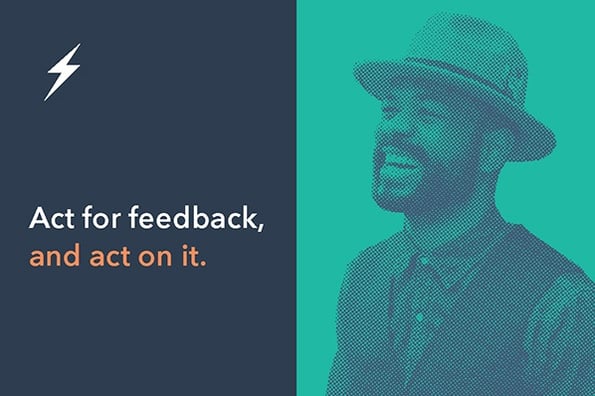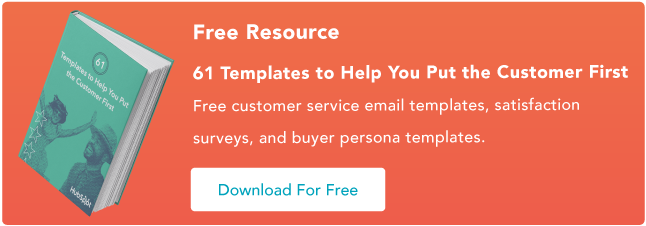Editor's note: This post is part of a series on the HubSpot Customer Code. You can subscribe to the series here.

We’ve made a habit of asking our customers for feedback.
We ask for feedback inside our software.
We ask for feedback via surveys.
We ask for feedback after someone talks to a customer service representative.
We gather feedback left on review sites.
We ask for feedback from our Advisory Board.
At last count, there are over 30 different channels through which we ask HubSpot customers for feedback.
Turns out, asking for feedback is the easy part. The hard part is acting on it.
This is the fifth tenet of the HubSpot Customer Code: Ask for my feedback, and act on it. I give us a 7 out of 10 on this.
We’re a team that cares a lot about the customer, and we know the power of asking for feedback, but we have some work to do on how we take action on that feedback.
Earlier this year we created the "Sharp Edges" initiative. There were some common areas in our customer experience that we knew were causing customer pain, but they were complex and cross-functional, we couldn’t quite quantify the pain, or figure out how to solve it. The initiative put a team of people in charge of fixing the sharp edges and assigned a Directly Responsible Individual (DRI), and the work finally got done.
It was an eye-opening experience for us.
How had a company that prides itself on solving for the customer allowed these painful experiences to be in existence for so long? The answer wasn’t all that exciting, it was simply that no one person was looking at the entire customer experience.
We needed a permanent DRI to speak on behalf of our customer across all touchpoints. One person to listen to all the feedback and help us understand how to act on it.
So we hired our first global Voice of the Customer lead.
This person is responsible for collecting all of our customer feedback into one place, analyzing it through a customer lens, prioritizing the work that needs to be done, getting it back into the hands of our business leaders for them to act on, tracking our progress on solutions, and finally -– maintaining this feedback in a way that anyone in the organization can access it and make sense of it.
This is a huge undertaking for us (and for this very small, new team), but key to helping to us improve on Tenet #5.
After we figure out how to operationalize customer feedback, I think there is one more thing we need to solve. How do we infer feedback without requiring customers to go through the effort of providing it?
The absence of a customer complaint is not a compliment.
The absence of feedback does not mean you have a fan.
As we all adjust to a world optimized by algorithms we increasingly expect companies to figure it out without us having to tell them. If I stop using an app or a piece of software, I might not complain, but it’s clear that I’m no longer deriving any value from it.
Uber knows when a trip takes longer than expected, they infer I won’t be thrilled about that.
Amazon knows when I’m about to buy digital content that I already own, they intervene.
Great companies don’t wait for complaints or assume that silence is a compliment. Great companies use data to understand how customers are likely to feel, and then acting before the customer ever complains.
Customers are giving us “feedback” all the time in the form of data – the tools they do and do not use in the platform, where they spend their time, how long they remain a customer.
HubSpot needs to operationalize this feedback as well.
Airbnb’s Data University has been a huge inspiration for how we’re thinking about this problem. They’ve built a team of data scientist who don’t just show up with data, they build tools and education that help people throughout the organization use data to make better decisions. We have a long way to go here, but this is exciting stuff.
Companies that ask for feedback grow fast. Companies that ask for feedback and consistently act on it grow better. And companies that figure out how to act on customer feedback without even needing to ask? Unstoppable.
This post is part 6 of 11 in a series on the HubSpot Customer Code. You can find more info on The Customer Code and how we score ourselves here, and watch my INBOUND talk on this topic here:
![→ Free Download: 61 Templates to Help You Put the Customer First [Download Now]](https://no-cache.hubspot.com/cta/default/53/a66c79d4-2a39-46e6-a80a-f7b999133c06.png)








![‘How Did You Hear About Us’ Survey Options: All-In-One Guide [+ Examples]](https://blog.hubspot.com/hubfs/how%20did%20you%20hear%20about%20us_featured.jpg)
![How to Write an Apology Letter to Customers [12 Templates & Examples]](https://blog.hubspot.com/hubfs/apology%20letter%20to%20customer_featured.jpg)
